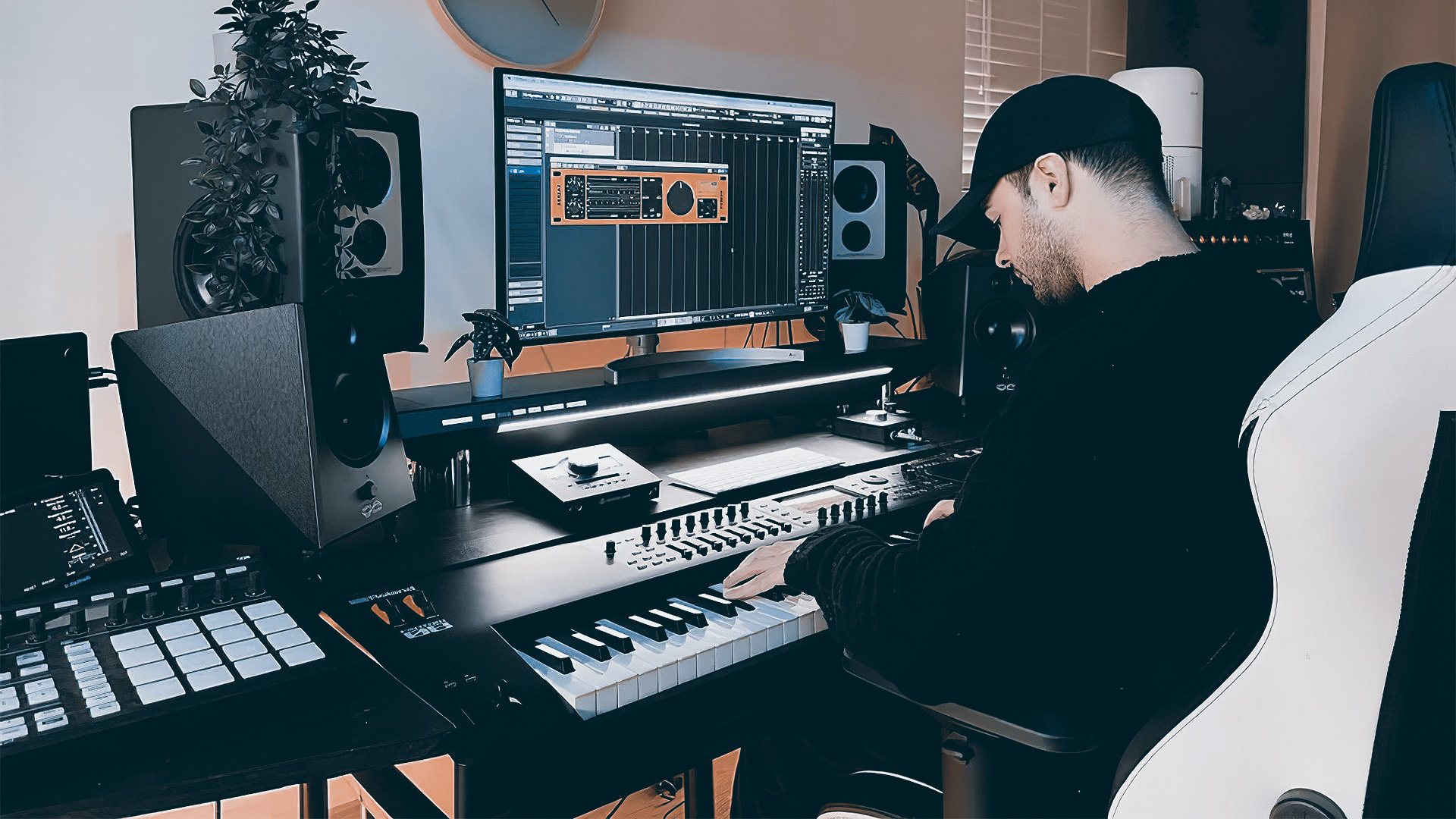Blog
How K-Pop is Produced – from Alawn a K-Pop Professional
15 Dec '2023
Get an insight into all the individual pieces that professionals like Alawn, use to help build a K-pop track.

In recent years, K-pop has become a global mainstream phenomenon. Even listeners who are out of touch with current pop music and pop culture will have at least heard of K-pop and some of its biggest stars, including BTS and BLACKPINK.
In 2022, K-pop album exports hit $230 million, and in the years 2020 and 2021, exports of K-pop grew by 82.6% and 62.1% respectively.
But what has led to K-pop being so commercially successful? Whilst K-pop is known for its flamboyant videos, eye-catching fashion and heart throb stars, at the core of the genre’s success lies the music, and behind that music are some of the most interesting music producers working today.
So, from a musical perspective, what makes K-pop, K-pop? What techniques and tools are the genre’s producers using to write such monumental hits that are taking the world by storm?
In this article we will be answering these questions. We’ll even be talking to Alawn, one of K-pop’s most in demand producers, and the artist behind many of the genre’s biggest global hits.
What does K-pop sound like?
K-pop is a fusion of many different popular genres and influences. There is no singular K-pop sound, and different groups and collectives are known for their unique approach. Some artists are known for jazzy ballads, whilst others are listened to for their unique take on Hip Hop or Trap.
Many K-pop artists sing in Korean, however, some artists such as BTS and BLACKPINK sing in both Korean and English. It’s no wonder that these two groups are probably the best-known K-pop exports amongst Western audiences, who can understand the English portions of the songs.
How is K-pop produced?
You may have heard stories of K-pop “factories” and wondered what that means. K-pop is a highly commercial genre, with business-savvy individuals and companies conceiving K-pop stars and groups, training them to be as commercially viable as possible.
This isn’t a practice that is unique to Korean pop music. One only needs to look as far as Simon Cowell and the success of artists signed to and developed by his label Syco Music such as One Direction, Labrinth, and Little Mix to see how this type of artist has existed within the Western pop culture landscape for decades.
K-pop is produced similarly to most of the pop music in the charts today, with many producers and songwriters collaborating on projects to achieve the optimum sound. Different producers and musicians are brought in to provide specific elements or provide new ideas at different stages of the writing process.
This should not be seen as a point that can be used to criticise K-pop however. Again, this is a practice that is very common in Western popular music. For example, Travis Scott and Drake’s 2018 hit SICKO MODE has upwards of 30 songwriters credited.
K-pop according to Alawn
Before his involvement in the K-pop scene, Alawn had already established himself as a sought-after producer, with production credits for Flo Rida, Snoop Dogg, Gucci Mane, Paul Wall and Boyz II Men.
However, after a writing camp in Seoul with SM Entertainment he quickly found an affinity with the genre of K-pop and soon found himself collaborating with many of the genre’s biggest stars.

His K-pop production credits include NCT 127’s Punch (Billboard #1 Album), SuperM’s 100 (Billboard #1 Album), Victon’s Mayday, KAI’s mega-hits Mmmh and Peaches, and WayV’s Kick Back.
Building on his success with K-pop, Alawn has also branched out into the burgeoning worlds of J-pop and C-pop including a placement with China’s biggest girl group 集合时刻 (JUST TEAM UP)
How would you define the K-Pop sound?
“At its heart, K-Pop is a genre of fusion. It’s known for its very dynamic structures, complex toplines, modal changes and blending multiple genres within the same song.”
How do you think that has changed over time?
“The sound of K-Pop is actually shifting quite a lot at the moment by taking more and more inspiration from Western Pop. We can notice productions becoming a lot more minimalistic, toplines being more repetitive and being simplified, with records such as “Seven” or “Cupid” leading this new wave.”
Would you say there are any key techniques or processes that have been invented by the genre?
“I definitely wouldn’t say it had been invented by K-Pop, but modal changes are very important in the genre with a lot of playful switches between major and minor chords.”
The genre draws influence from a range of styles and genres - Are there any key samples or sounds that are crucial when creating authentic K-pop?
“I think that K-Pop is so diverse and mixes so many different genres that there is no “sound” or key sample that defines the genre. But being so eclectic, sampling can definitely have a big part in its production when blending multiple genres, such as introducing an Indian flute as the main gimmick of a song, for example.”
With its outfits, dance routines, and music videos, K-Pop is known to have a vibrant image. How would you say this vibrancy is reflected in the music?
“I would turn this around and say that the energy and diversity within the music is what allows such vibrant music videos, choreographies, outfits etc. It all starts with the music and it’s being reflected in all creative aspects around it.”
What can producers of other genres learn from K-pop production techniques?
“The main thing for me would be how much more dynamic the song structures are. How to seamlessly go from one section to a different one without losing coherence and confusing the listeners is crucial. There are also many sections, a lot more than in any other genres, and being able to creatively push each one to the fullest is always a great challenge.”
Start producing K-pop today with Loopcloud
With over four million professional royalty-free samples at your fingertips, a Loopcloud subscription is an excellent way to get started producing K-pop.
Here are some sample packs that are available to Loopcloud members, carefully crafted with the eclectic and engaging genre of K-pop in mind.
Singomakers - K-Pop

Inspired by the sounds of legendary K-pop icons like BTS, TWICE, EXO, Red Velvet, iKON, Seventeen, Super Junior, Big Bang, SHINee, and SNSD, K-pop from Singomakers is loaded with hundreds of samples custom-made to give you the energy and feeling of K-pop in your productions!
In this pack, you’ll find drum loops, bass sounds, melodic loops, MIDI files, percussion one-shots and even vocal samples. If you’re looking for a sound library to act as a basis for your foray into K-pop, then look no further.
Singomakers - Songwriters Pop Tools

K-pop takes inspiration from many different styles of pop, and so this Songwriters Pop Tools pack from Singomakers is ideal for infusing your K-pop tracks with all that pop goodness.
Suitable for many different styles of pop including Pop, Future Pop, Deep Pop, House, Nu-disco, and more, you won’t be short of inspiration for your K-pop beats with this pack!
Both of these packs are available to Loopcloud members. You can try Looploud for free for 14 days with any membership option.
FAQs
Where is K-pop produced?
K-pop originated from South Korea, and is predominantly still made in the country. The “K” in K-pop stands for Korean. However, with the expanding global popularity of K-pop, the genre is known to be produced by artists all over the world.
Who produces K-pop music?
Some of the most popular K-pop producers include Alawn, LDN Noise, Newtype, Napi!er, Haeil, KB, Nine, and Collapsedone to name a few.
How is K-pop produced?
K-pop is produced similarly to most pop genres. Pop artists, songwriters, and producers will all collaborate with guidance from management and record labels to write songs.
For a wealth of information on music production, be sure to check out the Loopcloud Blog.

